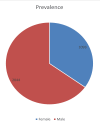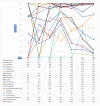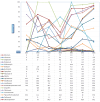Comprehensive Analysis of Salmonella Species Antibiogram and Evolving Patterns in Empirical Therapy: Insights From Tertiary Care Hospitals in Peshawar, Pakistan
- PMID: 38686255
- PMCID: PMC11057711
- DOI: 10.7759/cureus.57110
Comprehensive Analysis of Salmonella Species Antibiogram and Evolving Patterns in Empirical Therapy: Insights From Tertiary Care Hospitals in Peshawar, Pakistan
Abstract
Background Typhoid fever presents a significant challenge in developing nations, exacerbated by the emergence of antibiotic-resistant strains due to widespread prevalence and overuse of antibiotics. This study seeks to assess the antibiogram profiles of Salmonella species isolated from blood cultures of patients hospitalized at two prominent tertiary care hospitals in Peshawar, Pakistan: Khyber Teaching Hospital (KTH) and Hayatabad Medical Complex (HMC). By examining these profiles, the research aims to provide valuable insights into the evolving landscape of antibiotic resistance in the context of typhoid fever management. Materials and Methods This retrospective cross-sectional study utilized data gathered from two hospitals in Peshawar, KTH and HMC. Cases of enteric fever were identified based on positive blood cultures for Salmonella species. The study encompasses demographic information, seasonal prevalence, and antibiogram profiles of 3,137 cases that were presented between 2017 and 2023. Results Among the total 3,137 cases, males accounted for the majority, comprising 63% (2,044 cases). Particularly notable was the clustering of cases among children and adolescents aged one to 24 years. The incidence peaked during the months of summer and spring, from April to September. In terms of Salmonella Typhi isolates, considerable resistance was noted against first-line antibiotics such as amoxicillin/clavulanate (80.1%), co-trimoxazole/trimethoprim-sulfamethoxazole (66.6%), and chloramphenicol (86.9%), as well as against ceftriaxone (79.7%) and ciprofloxacin (51.6%). Conversely, certain antibiotics displayed higher sensitivity patterns, including meropenem (97.8%), doripenem (99.5%), imipenem (97.7%), ertapenem (96.5%), polymyxin B (99.4%), colistin (98.1%), and tigecycline (97.3%). Despite a limited sample size of 214 specimens, fosfomycin demonstrated a remarkable sensitivity of 93.4%. Sensitivities of amikacin and gentamicin were 90.7% and 81.5%, respectively. However, the sensitivity of azithromycin was concerning, standing at 66.5%. The antibiogram pattern for Salmonella exhibited significant and drastic changes. Conclusion In conclusion, this study sheds light on a higher prevalence of typhoid fever among males, with a notable seasonal peak observed during the summer and spring months. The age group most affected spans from one to 24 years. Salmonella isolates displayed significant resistance to conventional first-line antibiotics, alongside ciprofloxacin and third-generation cephalosporins. Azithromycin exhibited lower sensitivity compared to amikacin, gentamicin, and fosfomycin. The research advocates for the empirical use of amikacin, gentamicin, fosfomycin, and meropenem in the treatment of typhoid fever in Pakistan. Urgent measures, including regular Salmonella antibiogram surveillance, antibiotic stewardship, public health education, and Salmonella vaccination programs, are deemed crucial for primary disease prevention.
Keywords: amikacin; antibiogram; antibiotic resistance; antibiotic sensitivity; empirical therapy; enteric fever; fosfomycin; meropenem; pakistan peshawar; salmonella species.
Copyright © 2024, Ullah et al.
Conflict of interest statement
The authors have declared that no competing interests exist.
Figures







Similar articles
-
Antibiotic Susceptibility Patterns of Salmonella Typhi and Salmonella Paratyphi in a Tertiary Care Hospital in Islamabad.Cureus. 2020 Sep 3;12(9):e10228. doi: 10.7759/cureus.10228. Cureus. 2020. PMID: 33042671 Free PMC article.
-
Predictors of antibiogram performance and antibiotic resistance patterns in the northern Syrian region: A cross-sectional investigation.Explor Res Clin Soc Pharm. 2024 Jan 30;13:100416. doi: 10.1016/j.rcsop.2024.100416. eCollection 2024 Mar. Explor Res Clin Soc Pharm. 2024. PMID: 38352887 Free PMC article.
-
Antibiotics resistance as a major public health concern: A pharmaco-epidemiological study to evaluate prevalence and antibiotics susceptibility-resistance pattern of bacterial isolates from multiple teaching hospitals.J Infect Public Health. 2023 Dec;16 Suppl 1:61-68. doi: 10.1016/j.jiph.2023.09.019. Epub 2023 Oct 23. J Infect Public Health. 2023. PMID: 37880004
-
A review of clinical profile, complications and antibiotic susceptibility pattern of extensively drug-resistant (XDR) Salmonella Typhi isolates in children in Karachi.BMC Infect Dis. 2021 Sep 3;21(1):900. doi: 10.1186/s12879-021-06599-2. BMC Infect Dis. 2021. PMID: 34479478 Free PMC article. Review.
-
Evolving Epidemiology and Antibiotic Resistance in Enteric Fever: A Comprehensive Review.Cureus. 2024 Jun 24;16(6):e63070. doi: 10.7759/cureus.63070. eCollection 2024 Jun. Cureus. 2024. PMID: 39055401 Free PMC article. Review.
Cited by
-
Prevalence of the Antibiotic Resistance of Salmonella typhi and Salmonella paratyphi in Pakistan: A Systematic Review and Meta-analysis.Open Forum Infect Dis. 2025 Mar 11;12(4):ofaf131. doi: 10.1093/ofid/ofaf131. eCollection 2025 Apr. Open Forum Infect Dis. 2025. PMID: 40177589 Free PMC article.
-
Assessing Salmonella Typhi Pathogenicity and Prevention: The Crucial Role of Vaccination in Combating Typhoid Fever.Int J Mol Sci. 2025 Apr 23;26(9):3981. doi: 10.3390/ijms26093981. Int J Mol Sci. 2025. PMID: 40362220 Free PMC article. Review.
References
-
- Epidemiology, clinical presentation, and patterns of drug resistance of Salmonella Typhi in Karachi, Pakistan. Khan MI, Soofi SB, Ochiai RL, et al. J Infect Dev Ctries. 2012;6:704–714. - PubMed
LinkOut - more resources
Full Text Sources
Miscellaneous
